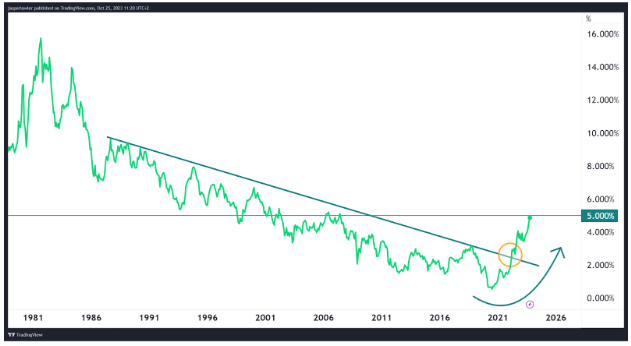The spike in the 10-year Treasury yield to 5% has spurred discussions about the implications for stocks, loans, and bonds in investment portfolios.
Here, we break down the implications and deliberate the decision to invest in Treasury bills or stocks and include a brief guide to understanding and buying US Treasury bonds.
What’s Happening?
- The 10-year Treasury yield has risen to 5%, a rate not seen in the last 16 years. This hike was triggered by Federal Reserve Chair Jerome Powell’s comments on persistent high US inflation, indicating that an additional rate hike might be in the offing.
- This increase in the Treasury yield affects various sectors of the economy, including mortgages, student debt, auto loans, and more. When the 10-year yield increases, it indirectly impacts many loans, making them costlier for new borrowers.
- Stocks are facing heightened competition from the bond market. Higher bond yields can make equities less attractive to investors seeking yield. This shift is evident as stocks have taken a hit across September and October.
What's Driving Treasury Yields Up?

Source: FlowBank, TradingView
There are several reasons for the spike
-
The Federal Reserve's aggressive rate hike strategy to combat inflation.
-
Inflation rates, although diminished from their peak, continue to exert pressure.
-
Rising oil prices stoking inflation fears.
-
Growing concerns over the US government's excessive borrowing and rising debt, causing investors to demand a higher return due to perceived repayment risks.
-
Gold and cash have taken preference over bonds as haven assets amid the war in Gaza.
The Impacts
Mortgages: The average rate for a 30-year fixed-rate mortgage has climbed to 8%. This makes housing less affordable, pushing potential homeowners to rethink buying decisions.
Student Loans: The cost of borrowing for education is rising. If the 10-year yield remains above 5%, federal student loan interest rates are likely to rise further.
Auto Loans: The cost of borrowing for vehicles has surged, making monthly payments more burdensome.
Savers: On the flip side, higher yields are good news for savers. Deposit rates are at their highest in over 15 years.
Stocks vs. Treasuries Debate
With the 10-year Treasury yield nearing 5%, stocks are facing heightened competition. Higher bond yields can make equities less attractive to investors seeking yield. This shift is evident as stocks have recently taken a hit.
For over a decade, low interest rates meant stocks were the go-to option for high returns while bonds offered portfolio stability. Now, with bond yields rising, the balance might be tilting.
Yet, the 10-year Treasury note now only just provides a "real" return, as its yield surpasses consumer inflation by approx 1% as of September’s CPI reading. By that standard the higher 9% average annual return for the S&P 500 over the last 10 years might still be worth taking the additional risk in order to beat inflation.
FYI: Treasury Bills and Notes Explained
The U.S. Department of the Treasury issues various securities to finance government spending. Among these, Treasury Bills (T-Bills) and the 10-year Treasury note are two prominent instruments.
T-bills are short-term securities ranging from one month to one year. Yield: Their yields have risen due to the Fed's interest rate hikes, making them more attractive than some other investment avenues. T-bills are typically sold at a discount. For example, a $1,000 T-bill might be purchased for $960 at a 4% discount. The profit is the difference between the maturity value and the purchase price.
The 10-Year Treasury Note, as the name suggests, these notes have a 10-year maturity. Unlike T-bills, these notes are sold at par, discount, or a premium and pay semi-annual interest. This note is often viewed as a benchmark for long-term interest rates and can influence borrowing costs for consumers and businesses alike.
How to Buy Treasuries
Via TreasuryDirect (Good for US investors)
Create and log in to your TreasuryDirect account.
Click “BuyDirect” and opt for “Bills” or "Notes" under “Marketable Securities.”
Specify your preferred term, auction date, and purchase volume.
Through Brokerage Accounts (Good for foreign investors)
Log in to your FlowBank app or other online brokerage account and select the bond according to the available yield and maturity. This route offers instantaneous access and a clearer yield picture, though potentially with marginally reduced returns compared to TreasuryDirect.
In Summary
The choice between stocks and T-bills isn't clear-cut. It depends on individual risk tolerance, investment goals, and market outlook.
While rising Treasury yields offer attractive returns with perceived lower risk, the stock market, though volatile, has the potential for higher long-term gains. As always, diversifying investments is a way to walk the line between taking advantage of near-term opportunities and meeting your long-term financial goals.
In the end, each investor needs to decide for themselves whether stocks are still worth it, or if T-bills are their preferred way forward. Regardless, FlowBank has them covered.




